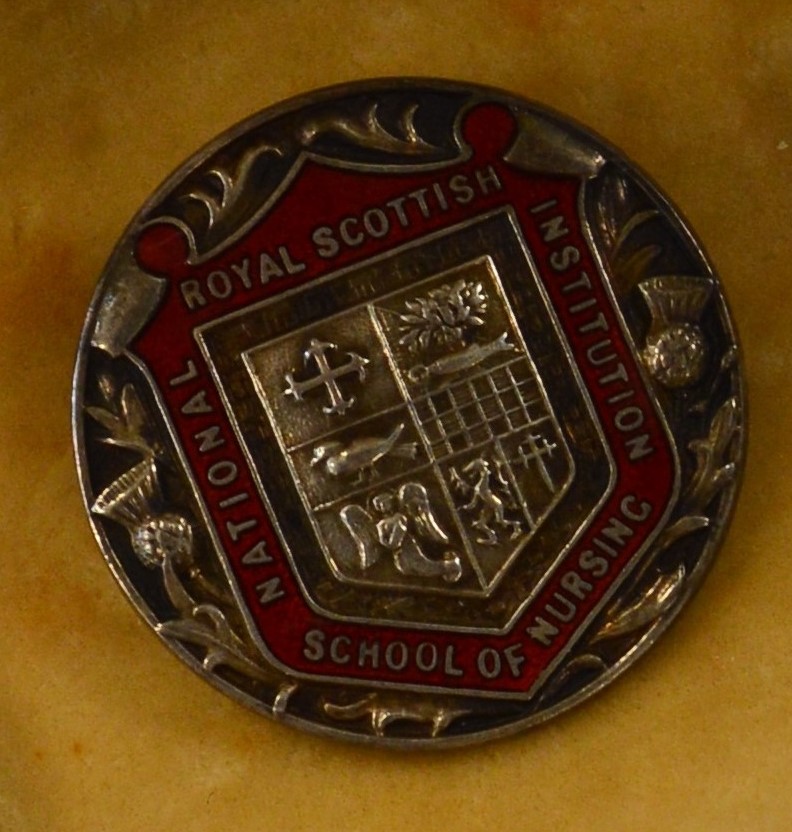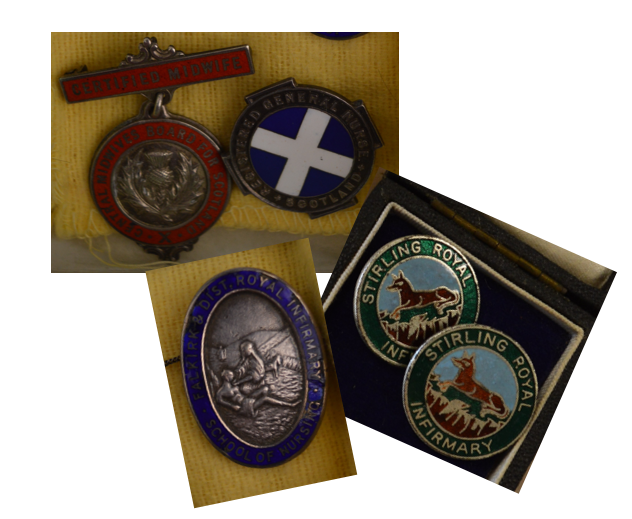When there is change and progress, what’s left? The answer is a treasure trove of documents and artefacts. Archives are a hidden resource in universities, libraries, museums, grand houses and company offices accessed perhaps over the internet but in my case, like many others, by personal visits to the establishment. Pencil and paper is the order of the day when reviewing and documenting the requested items although with permission, photographs can be taken of artefacts. Many hours transcribing information from the pencilled notes to a computer are needed before any meaning and significance can be extracted from the data.
While researching an aspect of 20th century nursing I accessed a selection of nurses’ badges donated to the archive which tell the story of nursing and midwifery training within what is now Forth Valley Health Board. Badges, no longer allowed, were worn on the old style uniform at collar level. There were two distinct types of badges, one for registration or enrolment within whatever field had been studied and the other was the hospital badge. The design and makeup of badges changed throughout the 20th century.

The national badges had the holder’s name and number inscribed on the back. If lost the bearer had to report the loss of the national badge to the police and the nursing or midwifery registration body as a finder could have used it to fraudulently obtain work as a nurse or midwife as it was in effect a legal document.
Hospital badges were – and still are – prized possessions, awarded with certificates on successful completion of a course and identifying the nursing training hospital. But they did not, in themselves, legally identify the wearer as a nurse or midwife. The badges for registered training often had a blue background whereas these awarded for enrolment often had a green background.
In the early 20th century, hospitals trained their own nurses on site within the hospital and staff often worked there for the rest of their career. Within what is now Forth Valley Health Board, nurse training took place at The Royal Scottish National Hospital, Falkirk and District Royal Infirmary, Bellsdyke Hospital and Stirling Royal Infirmary. Midwifery training took place at Falkirk and District Royal Infirmary and Stirling Royal Infirmary.

After the Second World War, to meet the national shortage of staff, a two year training for enrolment to the nursing register was planned and implemented. This meant there were two grades of trained staff: registered nurses and enrolled nurses. With advances in medical and nursing care, the different hospitals within Forth Valley – in a similar way to other hospitals throughout Great Britain – started grouping their nurse training courses together with neighbouring hospitals, offering those who trained a wider knowledge base. Meetings to plan these changes were documented in paperwork contained within the archive. It was decided to bring all the courses on offer under one roof. Starting in 1976 nursing and midwifery training was conducted at the Forth Valley College of Nursing and Midwifery with a suitable badge being designed and awarded, thus making the badges for the individual hospitals redundant. Training and education of nursing continued to change to keep pace with progress in healthcare and Forth Valley College of Nursing was integrated with the University of Stirling in 1997. The move to university education nationally and a change in uniform criteria spelt the death knell in the use of national or local badges. Many badges (and certificates) languish in the drawers of former and current nurses. Hopefully, their relevance will be remembered so their stories can be told and they can be donated to swell the archives, allowing people like me to stitch history together.

This blog post was contributed by Claire Brough Shearer. After a rewarding career in various nursing and midwifery roles, Claire is now a part time Research Post Graduate, reading for a PhD in an aspect of 20th Century Scottish nursing. Claire is the 2016 winner of the Monica Baly Bursary.